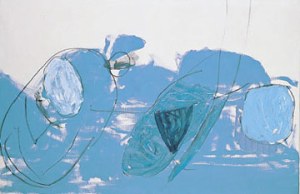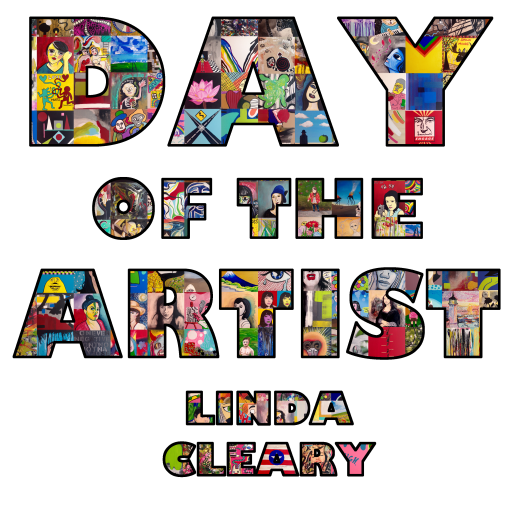It’s Day 133 and another HOT day. A nice day to spend mostly downstairs. I try not to complain when it randomly hits the 90s here in the Bay Area. We are lucky compared to most people! But the awesome weather has turned us into wusses. 😉 I had a good time painting today so join me in celebrating Roger Hilton today!


Roger Hilton CBE (1911–1975) was a pioneer of abstract art in post-war Britain. He was born in 1911 in Northwood, London and studied at the Slade School of Fine Art, London under Henry Tonks and also in Paris, where he developed links with painters on the Continent.
In World War II he served in the Army, part of the time as a Commando, for about

three years being a prisoner of war after the Dieppe raid of 1942. He worked as a schoolteacher for a time after the war, also teaching at Central School of Arts and Crafts, 1954-56.
During the 1950s and 1960s Hilton began to spend more time in west Cornwall, moving there permanently in 1965. In the same year he married Rose Phipps, 20 years his junior, having divorced his first wife, Ruth David.

He became a prominent member of the St. Ives Schoo land gained an international reputation. He won the 1963 John Moores Painting Prize, and was appointed CBE in 1968. By 1974 he was confined to bed as an invalid precipitated in part by alcoholism. His work became less abstract in his later years, often being based on the nude or images of animals. He died at Botallack, not far from St Ives, in 1975.
Biography is from wikipedia.
Below is excerpts from an article from http://www.independent.co.uk. by Tim Hilton (not his son).
ROGER HILTON treated art as an adventure, an attitude that helped to make him such a splendid exception among English painters. He set

off with little baggage, taking nothing from his intermittent studies at the Slade. Then, in the Thirties, he spent time in Paris. By the time of his maturity Hilton’s paintings were more reckless and radical than anything this country had seen before. This was in the early Fifties, when abstraction had few followers and many enemies. His best pictures still appear defiant of convention, though the Hayward Gallery’s retrospective puts them in context and shows how they were influenced.

Roger Hilton was the son of a German doctor practising in Middlesex named Hildesheim who changed his name during the First World War. Young Roger showed little academic aptitude and was never going to have a medical career so he was allowed to take up art at the end of the 1920s. In 1931 he was studying in Paris, probably to get away from his parents as well as to leave the Slade behind him. At the Academie Ranson he was impressed by Roger Bissiere, then an obscure artist but who later had an influence on the tachiste painters who came to prominence after the Liberation.
Hilton’s beginnings under Bissiere are not fully explained at the Hayward. No doubt many paintings have been lost. I once saw a beautiful

early work that reminded me of Braque. Obviously Hilton was likely to feel the overpowering vehemence of Picasso, who is copied in two paintings at the beginning of the exhibition. They are from 1947-49 when Hilton was, apparently, painting only sporadically. The Picasso-based pictures were surrealist and figurative. Then the show jumps forward and we find an artist who is more a master of his own means. In the canvases of 1951-52 there’s an abstract scaffolding. This sort of composition wasn’t original, but Hilton’s brush had found its own personality.
He liked to say that an artist was ‘a man swinging out into the void’, as though each painting was an exploration of the unknown, but certainly Hilton was given some comradely pushes as his swings were launched. A valuable guide was the Dutch painter Constant, who directed Hilton towards the vehement colour and expressive treatment of the Cobra artists and also made him think hard about Mondrian. This was an unusual conjunction. Cobra painters were wild and romantic, Mondrian was precise and classical. Somehow Hilton clamped them together.
Read the rest of this article here.
I hope you enjoy my piece today and I’m going to go eat a popsicle and hope it doesn’t melt before I eat it! I’ll see you tomorrow on Day 134. Best, Linda

Linda Cleary 2014
Acrylic on Canvas

May 2014- Tribute to Roger Hilton
Linda Cleary 2014
Acrylic on Canvas

May 2014- Tribute to Roger Hilton
Linda Cleary 2014
Acrylic on Canvas

May 2014- Tribute to Roger Hilton
Linda Cleary 2014
Acrylic on Canvas

May 2014- Tribute to Roger Hilton
Linda Cleary 2014
Acrylic on Canvas
